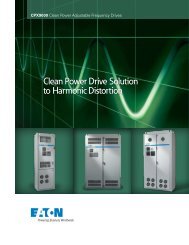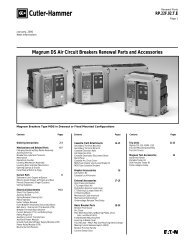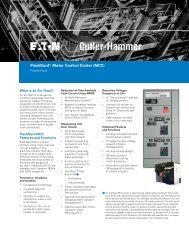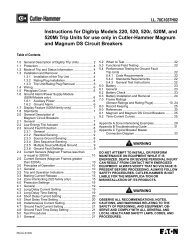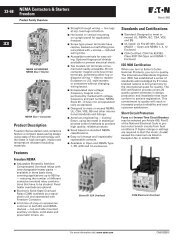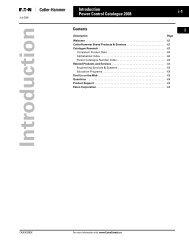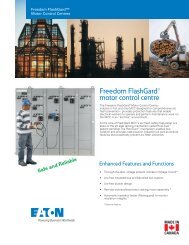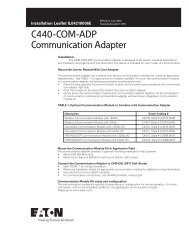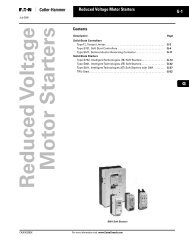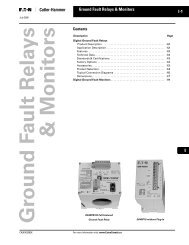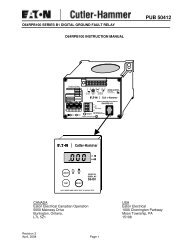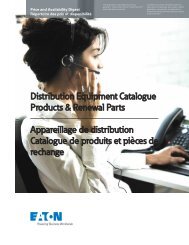molded case circuit breakers - Eaton Canada
molded case circuit breakers - Eaton Canada
molded case circuit breakers - Eaton Canada
Create successful ePaper yourself
Turn your PDF publications into a flip-book with our unique Google optimized e-Paper software.
116<br />
BUSWAY (LOW VOLTAGE)<br />
PRODUCT DESCRIPTION<br />
Standard<br />
Plug-in<br />
Low<br />
Impedance<br />
Feeder<br />
H5000<br />
Feeder<br />
High<br />
Frequency<br />
Typical Pow-R-<br />
Way Plug-in<br />
Straight Length<br />
Low voltage busway consists of aluminum<br />
or copper bars inside a metal housing<br />
used for power distribution. Busway is<br />
available in ampere ratings of 100 - 5000<br />
PRODUCT HISTORY<br />
Westinghouse began marketing low voltage<br />
busway in 1938. The first product<br />
offering was Power Distribution Busway,<br />
utilizing a multiple bolt joint that later<br />
evolved into Standard Plug-in Busway.<br />
Victory Bus Duct was developed during<br />
the Second World War to comply with<br />
federal limitations placed on usage of<br />
materials such as steel and copper which<br />
were critical to the war effort. In 1947,<br />
Westinghouse began manufacturing<br />
busway at the newly acquired facility in<br />
Beaver, PA with Standard Plug-in and<br />
feeder bus in ratings up to 1500 amperes.<br />
All of these early designs used separated,<br />
uninsulated bus bars inside a totally<br />
enclosed or perforated steel housing.<br />
In 1951, Low Impedance Feeder Busway<br />
was introduced as the first design to utilize<br />
heat shrinkable tubing for insulation on<br />
the bus bars and a ventilated steel housing.<br />
An internal ground bus was not available<br />
with this product line but provisions were<br />
made for mounting an external ground<br />
Low Resolution Photo Low Resolution Photo<br />
Low Resolution Photo<br />
Low Resolution Photo<br />
Electric<br />
Utility (DC)<br />
H5000<br />
Plug-in<br />
225-1000A<br />
Low<br />
Impedance<br />
Plug-in<br />
Current<br />
Limiting<br />
Typical Pow-R-<br />
Way II Plug-in<br />
Straight Length<br />
Amperes. Busway is available as feeder<br />
(indoor or outdoor) and plug-in. Feeder<br />
busway routes power from point-to-point,<br />
whereas plug-in busway allows for power<br />
bus directly to the busway housing. Low<br />
Impedance Feeder and Standard Plug-in<br />
Busway accounted for the majority of<br />
busway business written by Westinghouse<br />
through the 1950s and into the<br />
1960s. Low Impedance Plug-in Busway<br />
was introduced in 1961. With this<br />
design, the product offering was expanded<br />
to a maximum of 5000 amperes for feeder<br />
and 4000 amperes for plug-in.<br />
During the 1950s, various other designs<br />
were introduced to meet specific customer<br />
needs. Westinghouse Lifeline Unibus,<br />
rolled out in 1955, provided low impedance<br />
characteristics with plug-in openings<br />
and incorporated flexible armored cable<br />
into the design for use as elbows, offsets<br />
and flat to edgewise adapters.<br />
Westinghouse High Frequency Busway<br />
was introduced in 1958 to address the<br />
inherent problems of transmitting power<br />
at frequencies from 180 to 20,000 Hz. Cutler-Hammer<br />
also marketed High Frequency<br />
BV (balanced voltage) Busway during<br />
Low Resolution Photo Low Resolution Photo<br />
Low Resolution Photo<br />
Low Resolution Photo<br />
to be tapped off along a run as needed.<br />
Busway is typically used in manufacturing<br />
buildings and high rise office buildings.<br />
the late ’50s and early ’60s. Westinghouse<br />
High Frequency Busway and Cutler-<br />
Hammer BV Busway both found success<br />
in aircraft manufacturing plants, industrial<br />
induction heating systems, military missile<br />
and radar bases.<br />
Electric Utility Busway was also introduced<br />
by Westinghouse in 1958 and was designed<br />
to conduct direct current with low voltage<br />
drop. By 1963, Electric Utility Busway had<br />
been expanded to meet the growing industrial<br />
market for direct current power<br />
and was marketed simply as DC Busway.<br />
This product line was applied to feeding<br />
plating processes, welding installations,<br />
mill drives and motors.<br />
In 1958, Westinghouse sold the rights to<br />
the Lifeline Unibus product line to EDP of<br />
Allentown, PA which marketed EDP Unibus<br />
until 1962 when EDP became a wholly<br />
owned subsidiary of Cutler-Hammer.<br />
Cutler-Hammer successfully marketed<br />
Unibus until the product line was discontinued<br />
in 1974.<br />
March 2001



